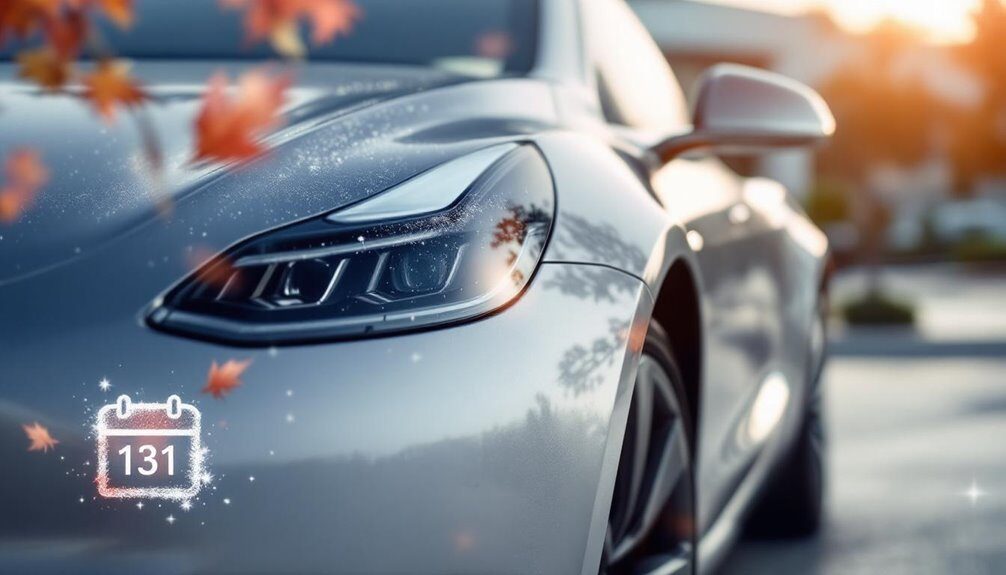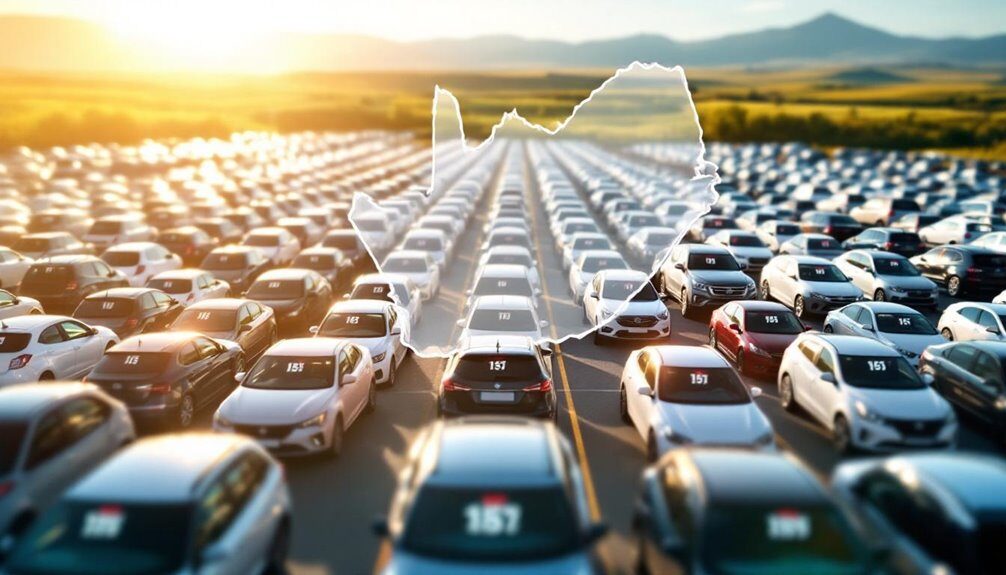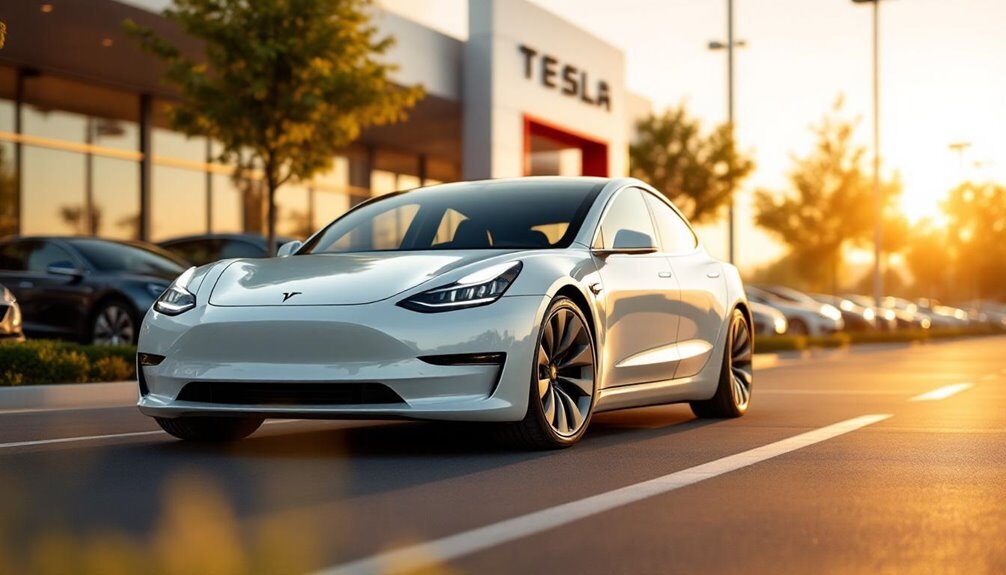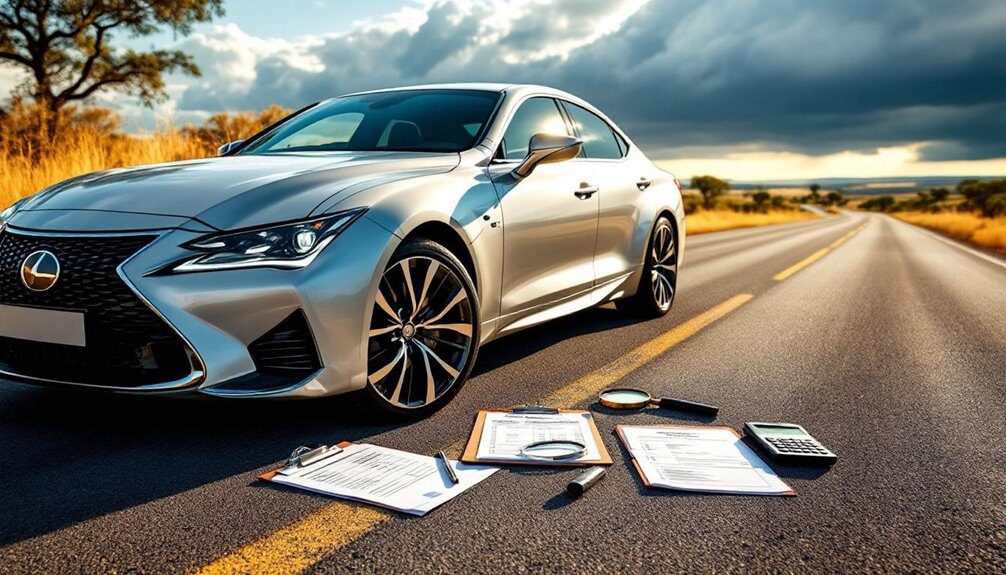South Africa’s safest bets? Mahindra XUV300 scored Africa’s first five-star Global NCAP rating—cheap and solid. Volvo XC60 brings premium protection with its City Safety tech and energy-absorbing cage. Toyota Corolla Cross nails five-star Euro NCAP with excellent child protection. Mercedes E-Class grabbed Euro NCAP’s 2024 Best Performer award. Volkswagen Tiguan also five-star rated. These models actually proved themselves in real crash tests, not marketing fluff. Your choice depends on what you’re actually driving—urban commuting versus family hauling changes everything.
Mahindra XUV300: Africa’s Safety Milestone
When the Mahindra XUV300 rolled through Global NCAP’s crash test facility, it didn’t just pass—it made history. You’re looking at Africa’s first five-star adult occupant protection rating. Period. The XUV300 scored 16.42 out of 17 for adult protection. That’s the highest ever recorded on the continent. It also nabbed a four-star child occupant rating—rare territory.
What sealed the deal? Exceptional side-impact performance. The bodyshell proved rock-solid under crash forces, maintaining stability where it counts most. Standard safety tech includes ABS, Electronic Stability Control, and side curtain airbags across all variants. ISOFIX anchors for rear seats. Seatbelt prompts everywhere. The test protocol’s evolution has ensured that mandatory safety features like side-impact protection and curtain airbags are now essential for achieving top ratings.
This isn’t just a vehicle that passes regulations. It’s built differently. The XUV300 represents what modern crashworthiness actually looks like in Africa. Vehicles with this calibre of safety engineering are increasingly available through dealerships offering nationwide delivery, ensuring that advanced protection reaches customers across the country. At Autobahn Motors, we believe expert automotive advice helps customers understand the importance of these safety innovations. The Hill Descent Control feature further demonstrates the manufacturer’s commitment to comprehensive active safety systems that work alongside passive protection elements.
Volvo XC60: Premium Protection and Performance
If you’re shopping for a premium SUV that doesn’t skimp on safety, the Volvo XC60 isn’t messing around. This thing earned top Euro NCAP marks and IIHS “good” ratings across crashworthiness categories. You’re getting an energy-absorbing ultrahigh-strength safety cage that actually works.
| Safety Feature | Performance |
|---|---|
| City Safety | 4-250 km/h operation |
| Pedestrian Detection | Up to 60 km/h avoidance |
| Oncoming Lane Mitigation | World-first steering intervention |
| Side Impact Protection | Maximum test points |
| Blind Spot Detection | 360° camera support |
The XC60’s IntelliSafe system includes Pilot Assist semi-autonomous driving and pedestrian detection with automatic braking. Nighttime detection works solid. Multiple airbags, reinforced cabin structure, seatbelt pretensioners—you’re looking at all-encompassing occupant protection. Driver fatigue monitoring catches drowsy driving before it becomes a problem. In rear-end collisions, the front seat and head restraints provide good whiplash protection through geometric assessment and design that keeps occupants safe. For owners prioritising maintenance excellence, quality assurance standards ensure replacement parts meet the same rigorous specifications as the vehicle’s original components. To keep your XC60 performing at peak safety levels, routine maintenance and regular check-ups are essential for long-term reliability and protection. This is Volvo doing what Volvo does best: keeping you alive.
Toyota Corolla Cross: Reliability Meets Safety
Toyota’s Corolla Cross doesn’t just talk a big game on safety—it actually delivers. You’re getting a 5-star Euro NCAP rating with 85% adult occupant protection and 83% for children. That’s solid. The Toyota Safety Sense 3.0 package includes lane-keeping assist and automatic emergency braking that genuinely responds to pedestrians and cyclists. It’s not just window dressing.
Front, side, and curtain airbags work together to keep you protected during impact. Yes, some lower trims skip certain advanced features compared to overseas models, but you’re still getting best-in-class protection relative to what else you’ll find locally. The eCall system automatically alerts emergency services after a crash. The Secondary Collision Brake prevents follow-up impacts automatically. Reliability meets safety here. You’re not sacrificing one for the other. Regular fluid replacements and maintenance help ensure these safety systems function optimally. For comprehensive automotive care to maintain your vehicle’s safety features, service appointment scheduling ensures your Corolla Cross stays in optimal condition.
Volkswagen Tiguan and T-Cross: European Engineering Standards
Volkswagen’s got a reputation for engineering, and these two—the Tiguan and T-Cross—are supposed to back that up. The Tiguan? It nailed a 5-star Euro NCAP rating. The T-Cross landed 3 stars. Both tested under European standards, which got tougher in 2023.
Look, the T-Cross scored 74% in Adult Occupant protection and 81% in Child Occupant tests. Not bad. But here’s the thing—driver chest protection came back weak.
The Tiguan, though, includes Lane Assist, Side Assist, and Autonomous Emergency Braking with pedestrian monitoring. T-Cross has Front Cross Traffic Assist and rear view cameras. Both pack eCall systems. For reliable maintenance of these vehicles, experienced technicians at local repair facilities can help keep your safety systems functioning properly. Regular brake maintenance and inspections are particularly important to ensure your vehicle’s stopping power remains optimal for safe driving.
Mercedes-Benz C-Class and E-Class: Luxury Safety Features
You’re looking at Mercedes-Benz’s E-Class lineup, and yeah, these luxury saloons don’t mess about with safety—they’ve got Euro NCAP certifications backing them up.
The real deal? Full-width rigid barrier testing shows genuinely good protection across all critical body areas for drivers and adequate-to-good coverage for rear passengers.
Side impacts and pole tests award maximum points, which basically means Mercedes engineered these things to handle what the road throws at you.
Euro NCAP Safety Certifications
Regarding safety certifications, Mercedes-Benz doesn’t mess around—and the numbers prove it. You’re looking at two models that basically own the Euro NCAP testing scene.
Here’s what sets them apart:
- The C-Class earned a “very good” driver assistance rating with 182 points—highest amongst six tested vehicles
- The E-Class scored Euro NCAP’s “Best Performer” 2024 award with a five-star overall safety rating
- Both vehicles feature Active Brake Assist that detects pedestrians, cyclists, and motorcyclists with near-perfect accuracy
These aren’t just fancy badges. You’re getting tested, verified safety tech that actually works in real scenarios—night driving, urban chaos, the whole deal.
That’s the kind of certification that matters when you’re behind the wheel.
Advanced Occupant Protection Systems
Mercedes-Benz’s occupant-protection arsenal doesn’t just cushion you when things go wrong—it actually tries to stop things from going wrong in the first place. The PRE-SAFE® system detects imminent collisions and springs into action before impact: tightening seat belts, adjusting passenger seats, moving head restraints forward. It even closes windows and sunroofs to block debris. Then there’s the acoustic side—specialised pink noise triggers your ear’s natural defence mechanism against crash trauma.
The C-Class and E-Class layer this with radar and camera tech that spot rear-end risks automatically. PRE-SAFE® Brake applies partial braking without you lifting a finger. Full emergency braking kicks in if you’re not responding fast enough. Evasive Steering Assist helps you dodge obstacles. It’s proactive safety, not reactive. You’re protected before the crunch happens. Regular routine maintenance services ensure these advanced safety systems remain calibrated and functioning at peak performance. To maintain optimal safety system performance, consider scheduling tyre service appointments with certified technicians who can inspect all vehicle systems comprehensively.
Essential Safety Technologies in 2026 Vehicles
You’ve probably noticed that modern cars basically think for themselves now—automatic emergency braking, lane-keeping assist, blind spot monitoring—they’re all working overtime to keep you from doing something silly behind the wheel.
Your 2026 vehicle’s got multiple airbags positioned strategically, a reinforced safety cage, and crumple zones engineered to absorb impact energy, which honestly beats relying on your reflexes.
Meanwhile, cameras and radar sensors are constantly scanning for pedestrians and obstacles, feeding real-time data to central processors that make split-second decisions faster than you can even react.
Driver Assistance Systems Evolution
By 2026, driver assistance systems aren’t just fancy add-ons anymore—they’re becoming the backbone of how cars keep you alive on South African roads. You’re looking at tech that actually works together, not just isolated gimmicks.
Here’s what’s changed:
- Sensor fusion—radar, lidar, and cameras collaborating for real environmental awareness instead of guessing
- Smarter interventions—automatic emergency braking that actually prevents crashes, not just warns you
- Driver monitoring—systems detecting fatigue and distraction before you cause problems
Lane-keeping assist no longer throws you around like it’s possessed. Responsive cruise control reads traffic realistically. Pedestrian detection works in low light. These systems talk to each other, to road infrastructure, even to other vehicles through V2X communication. You’re not just getting safety features anymore. You’re getting a co-pilot that’s genuinely invested in getting you home alive.
Structural Protection Technologies
Regarding actually surviving a crash in 2026, it’s not just about hoping the airbags work—modern cars are engineered from the ground up to protect you. Today’s vehicles use high-strength steel platforms and ring-shaped frame reinforcement that absorb collision energy like it’s their job. Because it is.
| Protection Feature | What It Does |
|---|---|
| High-Strength Steel Platforms | Disperses impact energy throughout the vehicle |
| Ring-Shaped Reinforcement | Strengthens cabin integrity during collisions |
| Impact-Absorbing Design | Minimises occupant harm through energy distribution |
| Eight+ Strategic Airbags | Covers multiple impact zones simultaneously |
| Reinforced Frames | Maintains structural stability post-collision |
You’re getting eight or more airbags strategically positioned. That’s not overkill—that’s redundancy doing what it should. These structures aren’t just meeting safety standards; they’re exceeding them. Your skeleton stays intact. That matters.
Global NCAP Testing Protocols and Ratings
When you’re shopping for a car—especially a used one—safety ratings matter more than you’d think. Global NCAP’s testing protocols are pretty rigorous. They’re running:
When shopping for a used car, safety ratings matter more than you’d think—Global NCAP’s testing protocols are rigorously comprehensive.
- Frontal offset crash tests at 64 kmph with 40% barrier overlap
- Side pole and side impact evaluations plus lane support system accuracy checks
- Five-star rating systems measuring occupant protection across different body regions
Here’s the thing: as of August 2025, they’ve tightened requirements considerably. Electronic stability programmes? Non-negotiable for five stars now. Seatbelt alerts. Curtain airbags for both rows. They’re basically saying “no shortcuts.”
Zero stars get handed out when injury measurements show serious or critical injury risks. It’s not perfect, but it beats guessing.
Safety Disparities Across Affordable Vehicle Segments
You don’t get the same safety bang for your buck across South Africa’s car market. Entry-level cars offer basic protection. Mid-range vehicles? They’ve got the good stuff. Luxury models? They’re in another universe entirely.
| Segment | Safety Features | Child Protection |
|---|---|---|
| Entry-Level | ABS, EBD, basic airbags | Lower ratings, fewer ISOFIX anchors |
| Mid-Range | ESC, traction control, ADAS | Above 80%, better restraints |
| Luxury | Blind-spot monitoring, responsive cruise, 360 cameras | Premium protection standards |
The gap’s real. Affordable compacts like the Nissan Magnite jumped from 2-star to 5-star ratings. Meanwhile, older budget models still lag. Structural integrity varies wildly too. Newer affordable vehicles absorb crash energy better than their predecessors, but premium models remain genuinely more resilient. Child occupant protection? That’s where disparities sting hardest. Budget vehicles average 3-star ratings whilst higher-priced models hit above 80%.
Emerging Trends in South African Vehicle Safety
South Africa’s vehicle safety environment is shifting—fast. You’re seeing ADAS features roll into mid-range models now, not just the fancy BMWs anymore. Insurance companies are literally rewarding you with discounts if your car’s got automatic emergency braking or lane-keeping assist. Smart, right?
ADAS features are moving beyond luxury vehicles into mid-range cars, with insurers now offering discounts for automatic emergency braking and lane-keeping assist.
Here’s what’s actually happening:
- Connected safety tech is expanding beyond fleet vehicles into private cars with real-time crash detection
- Structural innovations using high-strength steel and advanced composites are becoming standard across price points
- Consumer demand for NCAP 5-star ratings is pushing manufacturers to prioritise safety features
The Road Traffic Management Corporation’s tightening regulations mean electronic stability control could soon be mandatory. You’re looking at an environment where safety features aren’t luxuries anymore—they’re becoming expectations. That’s the shift.
Making Informed Choices for Maximum Protection
You’ve got to grasp those safety ratings—Global NCAP, Euro NCAP, the whole alphabet soup—because they actually tell you something real about how a car’ll protect you when things go sideways.
Then comes the fun part: comparing what features matter for *your* driving, whether that’s blind-spot monitoring for motorway commutes, lane-keeping assist for those long country roads, or just solid structural integrity across the board.
Here’s the blunt truth—the safest car isn’t always the fanciest one, and affordability doesn’t mean you’re gambling with your life anymore.
Understanding Safety Ratings
When you’re shopping for a used car—especially in a place like South Africa where road conditions can be unpredictable—safety ratings aren’t just some boring spec sheet you glance at.
They’re actual crash test data that tells you how a vehicle will perform when things go sideways. Literally.
Euro NCAP ratings dominate locally. You’ll see that 5-star scale, and here’s what matters:
- Adult Occupant Protection—how well the car shields you and your passengers
- Child Occupant Protection—critical if you’ve got young ones
- Safety Assist—active tech like ABS and automatic emergency braking that stops accidents before they happen
Different specs sold locally might’ve different ratings than overseas versions.
Always verify your exact model’s rating. It’s the difference between informed and guessing.
Comparing Key Features
Here’s the thing about safety features—they’ve moved way past airbags and seatbelts.
You’re looking at real tech now. Automatic emergency braking. Lane-keeping assist. Blind-spot monitoring. Electronic stability control that actually prevents skids on our chaotic roads.
When you’re comparing cars, don’t just glance at the star ratings. Dig into what’s actually protecting you. The Mahindra XUV300 pulls off five-star Global NCAP protection without destroying your budget. Toyota Corolla Cross and Mazda CX-60 both earned five-star Euro NCAP ratings with stellar child protection scores.
What matters? Multiple airbags. Structural integrity. How the car distributes crash forces. Stability systems that work together with ABS during emergency braking. These features aren’t luxury add-ons anymore. They’re standard on the safest vehicles worth considering.
Evaluating Your Priorities
Safety ratings mean nothing if they don’t match how you actually drive. You’re the variable that matters most.
Think about your real life:
- Family hauling? Child occupant protection scores above 80% aren’t negotiable—ISOFIX anchors and rear seat alerts save lives.
- Urban commuting? ABS, stability control, and multiple airbags handle city chaos better than fancy off-road credentials.
- Rural roads? Advanced stability systems and crash prevention tech matter when you’re hours from help.
Your vehicle choice isn’t about chasing five-star ratings for bragging rights. It’s about matching protection features to your actual driving patterns. A top-rated expedition SUV won’t help if you’re stuck in traffic daily. Similarly, an urban commuter car gets destroyed on rough farm roads.
Be honest. Where do you really spend time behind the wheel? That’s where safety investment counts.




